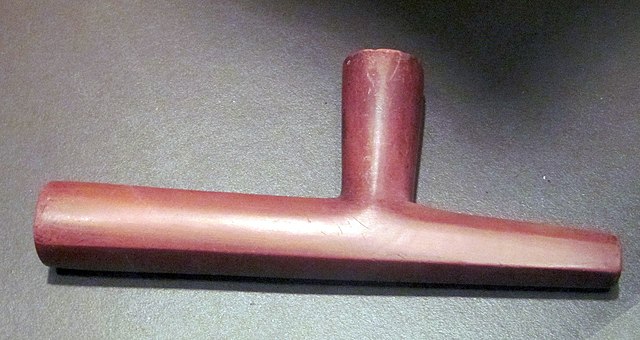A ceremonial pipe is a particular type of smoking pipe, used by a number of cultures of the indigenous peoples of the Americas in their sacred ceremonies. Traditionally they are used to offer prayers in a religious ceremony, to make a ceremonial commitment, or to seal a covenant or treaty. The pipe ceremony may be a component of a larger ceremony, or held as a sacred ceremony in and of itself. Indigenous peoples of the Americas who use ceremonial pipes have names for them in each culture's Indigenous language. Not all cultures have pipe traditions, and there is no single word for all ceremonial pipes across the hundreds of diverse Native American languages.
A pipestem from the upper Missouri River area, without the pipe bowl, from the collection of the Peabody Museum of Archaeology and Ethnology.
Catlinite bowl of a ceremonial pipe used by Black Hawk, on display at Black Hawk State Historic Site.
Catlinite Inlayed Pipe Bowl with Two Faces, early 19th century, Sisseton Sioux
Uncompahgre Ute Salmon alabaster ceremonial pipe. Ute pipe styles are similar to those of the Plains Indians, with notable differences. Ute pipes are thicker and use shorter pipestems than the plains style and more closely resemble the pipe styles of their Northern neighbors, the Shoshone.
A tobacco pipe, often called simply a pipe, is a device specifically made to smoke tobacco. It comprises a chamber for the tobacco from which a thin hollow stem (shank) emerges, ending in a mouthpiece. Pipes can range from very simple machine-made briar models to highly prized hand-made artisanal implements made by renowned pipemakers, which are often very expensive collector's items. Pipe smoking is the oldest known traditional form of tobacco smoking.
Peterson System Standard Pipe
Inlayed Pipe Bowl with Two Faces, early 19th century, Brooklyn Museum
Pipes made of bamboo buds (handmade)
Smoking a bamboo-bud pipe







